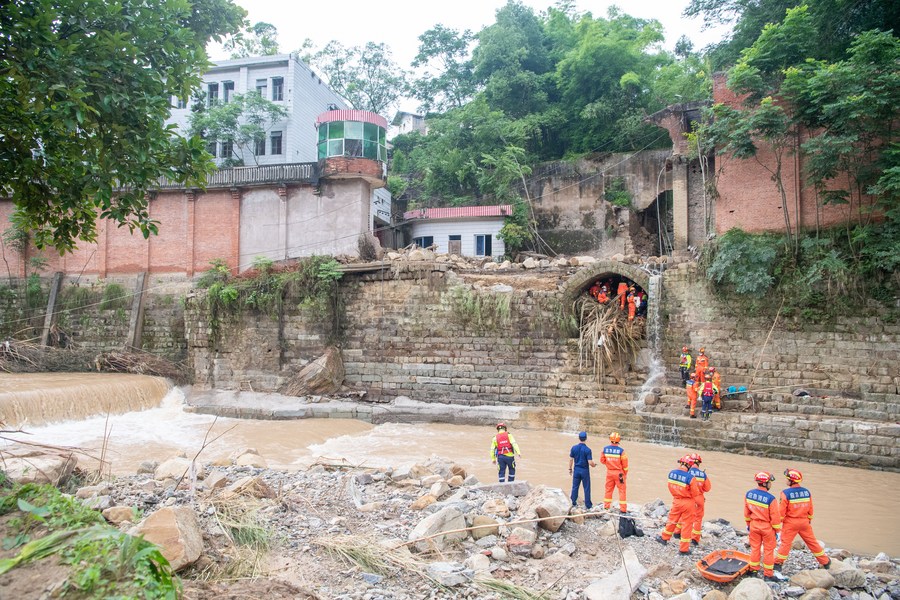China on high alert for summer flooding, heatwaves

Rescue team members work in Linchang Village of Changtan Township, Wanzhou District of Chongqing Municipality, southwest China, July 6, 2023. (Xinhua/Tang Yi)
BEIJING, July 7 (Xinhua) -- China is on high alert for both summer floods and persistent heatwaves, as its major river basins enter the main flood season this month, while unusually torrid weather scorches northern China.
China's national observatory renewed its orange alert for high temperatures on Friday, with some northern Chinese cities, including Beijing and Tianjin, facing sweltering temperatures of up to 41 degrees Celsius. The conditions follow the strongest June heatwave in a decade, putting pressure on the power supply.
The Ministry of Water Resources (MWR) on Thursday launched a level-four emergency response to flooding in the southern Chinese provincial regions of Jiangsu, Anhui, Hubei, Chongqing and Guizhou, with authorities issuing daily warnings of rain-triggered geological disasters and flash floods since the start of the week.
FLOOD CONTROL ACTIVATED
A blue alert has been renewed in anticipation of downpours from 8 p.m. Friday to 8 p.m. Saturday, with heavy rain or rainstorms due in parts of Inner Mongolia, Jilin, Liaoning, Chongqing, Guizhou, Hunan, Hubei, Anhui, Jiangsu and Shanghai.
Local governments and residents have been advised to take appropriate precautions. Schools and kindergartens need to ensure the safety of students and children, while drivers should be alert and cautious due to waterlogged roads and traffic jams.
As of Thursday night, the July rainstorms in southern China had claimed 17 lives in Chongqing Municipality, with 461,000 people affected in the neighboring Sichuan Province as of Tuesday.
To support flood and geological disaster relief work in regions including Chongqing and Sichuan, China earmarked 320 million yuan (about 44.4 million U.S. dollars) on Wednesday from its central natural-disaster relief funds.
Starting mid-July, the country will enter the critical month-long window of flood response, with its seven largest river basins, including the Yangtze River, Huaihe River and Yellow River, entering the main flood period.
So far, both rainfall and river flooding have been moderate nationwide, according to the Ministry of Emergency Management (MEM). Still, it warns of inundation risks on some major rivers and lakes, windstorms and hail across China, as well as typhoons rampaging in southern and southeastern areas.
Authorities are on the move. The MWR on Wednesday pledged to protect people's lives and prevent damage in reservoirs, important dikes and infrastructure. The Red Cross Society of China said it had sent task forces to guide flood control and disaster relief in Chongqing. Local governments of rain-drenched Shandong, Shaanxi, Hunan, Jiangxi and Yunnan are also on high alert.
HEATWAVES PERSIST
China is being hit by heatwaves of rare intensity this year, especially in northern areas, which are traditionally cooler than the south. Since mid-June, an onslaught of red alerts for high temperatures in northern cities like Beijing, Tianjin, Shijiazhuang and Jinan made social media headlines.
The country is set to see the scorching heatwaves for the rest of July and August in regions including northern China and southwest China, weather forecasters say.
The torrid heat brings risks of forest fires, traffic accidents, power and energy crunches, as well as heat-related illness. The National Meteorological Center said road-surface temperatures on expressways in the Beijing-Tianjin-Hebei region and beyond could be up to 62 degrees Celsius from Wednesday to Saturday, and has advised precautions in case of events like flat tires.
China's power supply has been under pressure, with the recent peak load on electricity grids exceeding 900 million kilowatts. The China Electricity Council expects the nationwide peak load to hit 1.37 billion kilowatts this year, up 80 million kilowatts from 2022.
The State Grid says it is ramping up the power supply by connecting a new 11.78-million-kilowatt generator module to the grid, while doubling down on emergency maintenance nationwide. The National Energy Corporation has made contingency plans for coal purchases, while major nuclear power and hydropower plants are ready for peak summer demand.
The high temperatures have also caused droughts of varying degrees in breadbasket regions like Inner Mongolia, Jilin, Liaoning, Hebei and Shandong, threatening agricultural production. The Ministry of Agriculture and Rural Affairs, together with other authorities, has issued a joint contingency plan for drought in northern regions to help secure a bumper harvest.
To ensure the safety of the country's workforce, the All-China Federation of Trade Unions has issued a circular stressing protection of the rights and interests of people exposed to heat in their workplaces. Construction sites in Beijing are asked to prolong rest hours for workers, while some courier firms are providing sun protection clothing for employees.
Photos
Related Stories
- China activates emergency response to flooding
- China ramps up efforts against floods as heavy rains kill at least 15
- China launches emergency response in flood-hit Chongqing
- China sends team to Henan to guide flood relief
- South China provinces told to brace for river flood
- China steps up flood prevention work in at-risk reservoirs
Copyright © 2023 People's Daily Online. All Rights Reserved.









